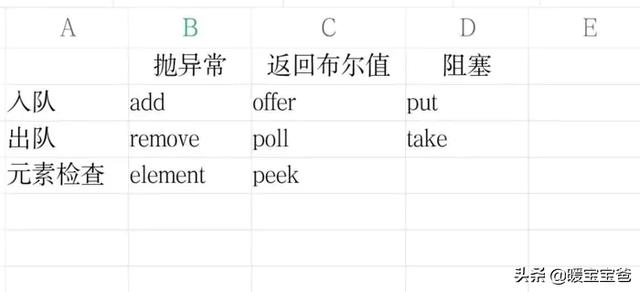引言:
java.util.concurrent.BlockingQueue阻塞队列,通常用于一个线程生产对象,并放入队列,另外一个线程获取并消费这些对象的场景,很多消息框架都有类似实现。
接口实现方法简介:
如下图所示:
入队时,因容器限制导致插入异常,使用add会抛出IllegalStateException,使用offer则直接返回false,使用put则会线程阻塞直到可以入队。
出队情况一样。

接口实现类简介:
BlockingQueue是个接口,目前有以下几个类实现了BlockingQueue接口:
ArrayBlockingQueue:
一个内部元素由数组存放的有界阻塞队列。初始化的时候必须设定容量,用先进先出(FIFO)的方式对元素进行入队和出队。
DelayQueue:
DelayQueue中内部使用的是PriorityQueue存放数据,其中的元素必须实现Delayed接口,可以判断元素的延迟是否达到,如果达到则该元素将会在DelayQueue的下一次take被调用的时候出队。
LinkedBlokingQueue:
无界阻塞队列,以 链表 结构对元素进行存储,用先进先出(FIFO)的方式对元素进行入队和出队。
PriorityBlockingQueue:
有优先级的无界阻塞队列,元素必须实现java.lang.Comparable接口,用来作为优先级的比较。因此在该队列中元素的排序取决于元素类中的实现。
SynchronousQueue:
同步队列,这是一个特殊的队列,内部一次只能容纳一个元素。如果该队列已存在一个元素,往该队列中插入一个元素的线程将会被阻塞,直到其他线程将该队列内的元素从队列中出队。
ArrayBlockingQueue源码实现:
1.属性值
final Object[] items;
int takeIndex;
int putIndex;
int count;
final Reentrant lock lock;
private final Condition notEmpty;
private final Condition notFull;
如上所示,数据存放在items这个数组,入队和出队的索性各一个,当前容量count,入队出队共享的锁lock,非空的条件Condition及非满的条件Condition。
2.入队操作(以offer为例)
步骤一,检查元素e不为null,获取超时时间,获取可重入锁。
步骤二,如果count=items.length(队列的数组已经存满):如果超时时间为负,则失败;否则线程在。
步骤三,进入enqueue方法,添加元素,增加count值,唤醒在notEmpty这个Condition的等待队列上等待读取队列数据的线程。
public boolean offer(E e, long timeout, TimeUnit unit)
throws InterruptedException {
checkNotNull(e);
long nanos = unit.toNanos(timeout);
final ReentrantLock lock = this.lock;
lock.lockInterruptibly();
try {
while (count == items.length) {
if (nanos <= 0)
return false;
nanos = notFull.awaitNanos(nanos);
}
enqueue(e);
return true;
} finally {
lock.unlock();
}
}
private void enqueue(E x) {
// assert lock.getHoldCount() == 1;
// assert items[putIndex] == null;
final Object[] items = this.items;
items[putIndex] = x;
if (++putIndex == items.length)
putIndex = 0;
count++;
notEmpty. signal ();
}
3.出队操作(poll为例)
步骤一,获取超时时间,获取可重入锁。
步骤二,如果count == 0(容量为空)。如果超时时间为负,则失败;notEmpty这个Condition的等待队列中 的情况,延迟时间到依然需要等待while循环结束
步骤三,进入dequeue方法,删除元素,count值,唤醒在notEmpty这个Condition的等待队列上等待将数据入队的线程。
public E poll(long timeout, TimeUnit unit) throws InterruptedException {
long nanos = unit.toNanos(timeout);
final ReentrantLock lock = this.lock;
lock.lockInterruptibly();
try {
while (count == 0) {
if (nanos <= 0)
return null;
nanos = notEmpty.awaitNanos(nanos);
}
return dequeue();
} finally {
lock.unlock();
}
}
private E dequeue() {
// assert lock.getHoldCount() == 1;
// assert items[takeIndex] != null;
final Object[] items = this.items;
@SuppressWarnings(“unchecked”)
E x = (E) items[takeIndex];
items[takeIndex] = null;
if (++takeIndex == items.length)
takeIndex = 0;
count–;
if (itrs != null)
itrs.elementDequeued();
notFull.signal();
return x;
}
总结:
如下图所示,ArrayBlockingQueue在一个给定的数组中,通过两个index进行循环,做到入队出队的操作。
队列为空时,使用notEmpty这个Condition让队列出队的线程阻塞等待。
当队列满时,使用notFull这个Condition让队列入队的线程阻塞等待。
入队出队使用的是同一个lock,同一时间只能做一个,因为是重入锁,持有锁的同个线程再次进入可直接进入。
Condition操作可参考本人之前结束的文章。

LinkedBlokingQueue源码实现:
1.属性介绍
static class Node<E> {
E item;
/**
* One of:
* – the real successor Node
* – this Node, meaning the successor is head.next
* – null, meaning there is no successor (this is the last node)
*/
Node<E> next;
Node(E x) { item = x; }
}
private final int capacity;
private final AtomicInteger count = new AtomicInteger();
transient Node<E> head;
private transient Node<E> last;
private final ReentrantLock takeLock = new ReentrantLock();
private final Condition notEmpty = takeLock.newCondition();
private final ReentrantLock putLock = new ReentrantLock();
private final Condition notFull = putLock.newCondition();
如上代码所示,由Node节点构成的链表结构
head和last作为头尾,因为是transient类型,可以判断头尾不是存放具体元素的节点。
capacity是容量,为空时,容量默认是Integer.MAX_VALUE。
锁有takeLock和putLock两个,入队和出队各自处理,不相互影响。
count容量因可能有入队出队两个线程操作,使用原子操作类。
2.入队操作(以offer为例)
从如下代码可以看出,与ArrayBlockingQueue的入队操作基本类似,只有以下几点差异:
1.使用putLock防止入队操作争用,对出队操作无影响。
2.链表插入处理与数组不同
3.count原子操作类,累加方法特殊。
public boolean offer(E e, long timeout, TimeUnit unit)
throws InterruptedException {
if (e == null) throw new NullPointerException();
long nanos = unit.toNanos(timeout);
int c = -1;
final ReentrantLock putLock = this.putLock;
final AtomicInteger count = this.count;
putLock.lockInterruptibly();
try {
while (count.get() == capacity) {
if (nanos <= 0)
return false;
nanos = notFull.awaitNanos(nanos);
}
enqueue(new Node<E>(e));
c = count.getAndIncrement();
if (c + 1 < capacity)
notFull.signal();
} finally {
putLock.unlock();
}
if (c == 0)
signalNotEmpty();
return true;
}
private void enqueue(Node<E> node) {
last = last.next = node;
}
出队操作差不多,不再赘述。
PriorityBlockingQueue源码实现:
1.基本属性实现
private static final int DEFAULT_INITIAL_CAPACITY = 11;
private static final int MAX_ARRAY_SIZE = Integer.MAX_VALUE – 8;
private transient Object[] queue;
private transient int size;
private transient Comparator<? super E> comparator;
private final ReentrantLock lock;
private final Condition notEmpty;
private transient volatile int allocationSpinLock;
private PriorityQueue<E> q;
如上代码所示:
默认队列容量11
最大的队列容量为Integer.MAX_VALUE – 8
queue是队列元素存放的数组,size是当前队列中元素的个数
comparator是元素比较器,比较结果将决定元素的队列顺序
lock是出队入队的共享锁
allocationSpinLock是扩容数组分配资源时的自旋锁,CAS需要使用。
2.入队过程(以offer为例)
如下代码所示,
在入队时,判断容量是否满足需要,如果不满足,使用tryGrow扩容。
siftUpComparable是真正的插入操作方法。
而在siftUpComparable中,逻辑上使用二叉树的方式进行数据存储和获取,从而实现有优先级的获取功能。
siftUpComparable过程如下所示:
先插入到最后节点,再和父节点比较大小,小于则内容互换(结构不变,内容替换)。

入队操作
代码如下:
3.出队过程(以poll为例)
如图所示,出队的总是当前树的根节点(最小),并取最后一个节点,与当前节点的右叶子节点比较,如果小于则互换,再与父节点比较,如果小于互换,再往父节点重复该步骤,以此方式调整树的结构。

4.数组扩容
如下代码所示,根据allocationSpinLockOffset标志进行CAS操作,判断扩容是否有线程在操作,不使用阻塞锁的方式进行并发处理。
如果扩容步骤已被其他线程抢占,则让出执行权限。
private void tryGrow(Object[] array, int oldCap) {
lock.unlock(); // must release and then re-acquire main lock
Object[] newArray = null;
if (allocationSpinLock == 0 &&
UNSAFE.compareAndSwapInt(this, allocationSpinLockOffset,
0, 1)) {
try {
int newCap = oldCap + ((oldCap < 64) ?
(oldCap + 2) : // grow faster if small
(oldCap >> 1));
if (newCap – MAX_ARRAY_SIZE > 0) { // possible overflow
int minCap = oldCap + 1;
if (minCap < 0 || minCap > MAX_ARRAY_SIZE)
throw new OutOfMemoryError();
newCap = MAX_ARRAY_SIZE;
}
if (newCap > oldCap && queue == array)
newArray = new Object[newCap];
} finally {
allocationSpinLock = 0;
}
}
if (newArray == null) // back off if another thread is allocating
Thread.yield();
lock.lock();
if (newArray != null && queue == array) {
queue = newArray;
System.arraycopy(array, 0, newArray, 0, oldCap);
}
}
以上是关于阻塞队列的第一部分,DelayQueue,SynchronousQueue在后面章节中进行学习


